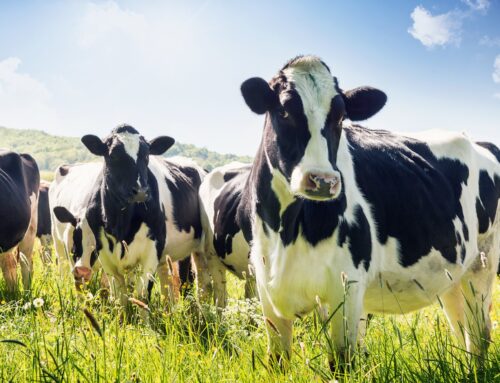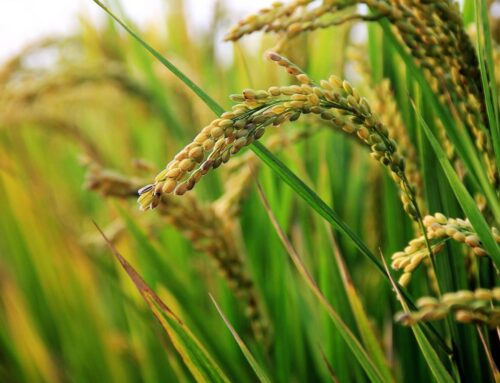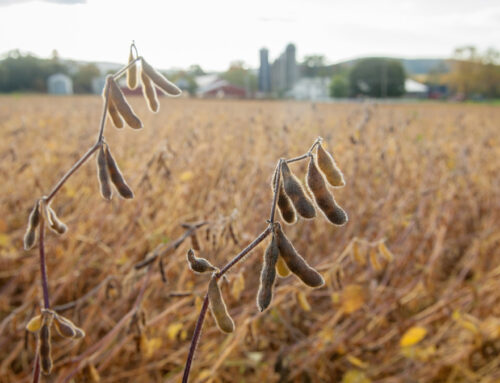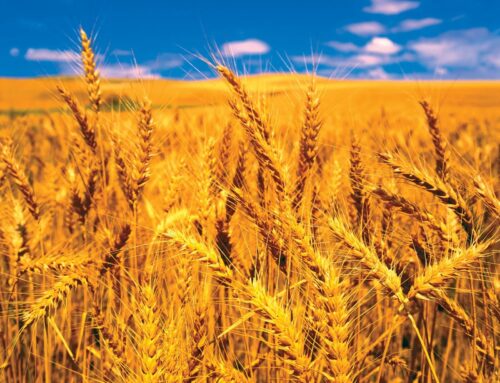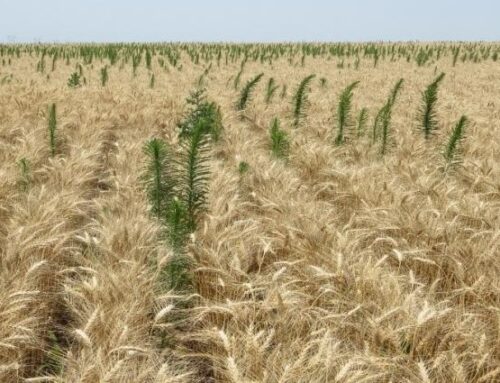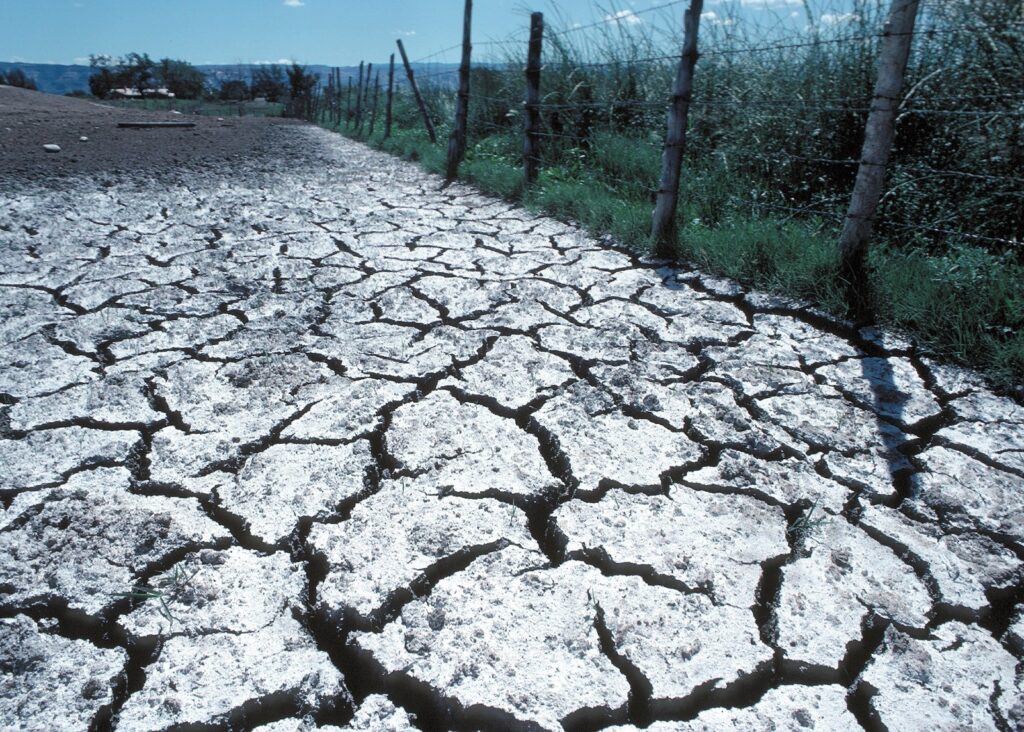
Calcium sulfate sources like gypsum dihydrate and gypsum anhydrite bind with the salts, moving water and sodium downward in soils.
Rain makes grain. There can be too much of a good thing, though. Year after year of rampant rainfall has fueled saline and sodic soils in eastern South Dakota and eastern North Dakota.
In South Dakota alone, it’s estimated these soils tally 7.6 million acres. Crops struggle or surrender on these white-caked soils. In many cases, farmers simply give up. Don’t.
“Except for the sodium, these areas are the best soils on my farm,” says David Gillen, White Lake, South Dakota.
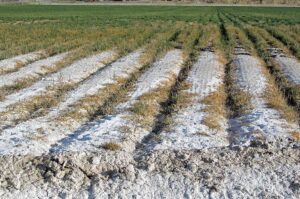 Still, spots like these need some fixing. You may need to cease crop production on them several years. With $2.50- to $3-per-bushel corn (or lower), though, you aren’t missing much.
Still, spots like these need some fixing. You may need to cease crop production on them several years. With $2.50- to $3-per-bushel corn (or lower), though, you aren’t missing much.
“The idea is to clean them up, so if corn gets up to $5, $6, $7, and $8 per bushel again, they’ll be productive,” says Gillen. “You can’t be competitive if you have $500 per acre of inputs and get zero yield on these spots.”
Saline soils are high in salts derived from ancient sedimentary rocks. Heavy rainfall prompts these salts to rise to the surface due to a rising water table.
“When water evaporates from the surface, salts remain,” says Cheryl Reese, South Dakota State University (SDSU) soil scientist. No-till fields soaked by rainfall or low-quality irrigation water are suspect.
Salts don’t plague sodic soils. Instead, these soils have high sodium levels. Sodium prompts clay particles in these soils to randomly disperse. This dispersion slows water infiltration, increases erosion, and forms gullies.
Saline and sodic areas may also impact conventionally tilled sodic and saline soils.
Pierpont’s Puzzle
Precipitation that’s pummeled Pierpont, South Dakota, in the 2000s shows what these farmers face.
From 1951 to 1960, precipitation tallied 17 inches per year in this northeast South Dakota town. From 2001 to 2010, annual precipitation leaped to 25 inches.
If this were 1822 rather than 2022, the native prairie grasses would be able to soak up this excess water and cycle the resulting salts and sodium back into deep subsoil.
“Switchgrass has a massive root system that goes deep into the soil,” says Reese.
That’s changed. These days, corn and soybeans flanked by occasional spring wheat is the northeastern South Dakota norm.
“Compared with switchgrass, these crops don’t use a lot of water,” says Reese. At best, soybeans use water for 2.5 months each year. This leaves no crop to lap up water the rest of the year.
Sample First
Soil sample to see if you have sodic or saline soil. Soil readings can be gathered with a variety of tools that measure electrical conductivity (EC). The higher the EC, the higher the salt content. Most labs define a soil as saline if the EC has a reading of 4 deciSiemens per meter or more.
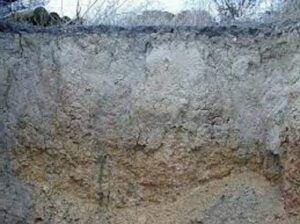 Assessing field sodium content includes calculating the soil’s solution sodium adsorption ratio (SAR) value or the exchangeable sodium percentage (ESP). In the Dakotas, values exceeding 4 and and 5 indicate a serious problem. Contact a local Extension agent or knowledgeable soil consultant to help you make these calculations.
Assessing field sodium content includes calculating the soil’s solution sodium adsorption ratio (SAR) value or the exchangeable sodium percentage (ESP). In the Dakotas, values exceeding 4 and and 5 indicate a serious problem. Contact a local Extension agent or knowledgeable soil consultant to help you make these calculations.
Tile drainage can slice soil salinity. It’s not a sole strategy, though. That’s particularly true with compacted soils, as water cannot pass through them. You also need an outlet for tile water to flow, which doesn’t always exist in South Dakota.
Crops like salt-tolerant alfalfa initially planted along the rims of impacted soils can gradually restore productivity. “These can lower the water table and intercept excess water as you work your way from rims into saline- and sodic-soil areas,” says Doug Malo, SDSU soil scientist.
The Gypsum Solution
Since his son, Bryce, has a tile-installation business, they tiled most sodic pockets where outlets exist. Calcium sulfate source like gypsum or anhydrite applications work in conjunction with the tiling.
Gillen uses salt-zone maps of salty pockets in which he can vary gypsum rates and seed. Gypsum and anhydrite bind with the salts, moving water and sodium downward in soils. And when used together with tiling and gypsum and anhydrite can also lower pH in high-pH soils.
“Soils with pH levels of 8 or above can make nutrients less available to the plant,” says Malo.
At $240 per ton, gypsum application costs $100 per acre.
Tall Wheatgrass
Gillen also plants tall wheatgrass in and on areas bordering sodic soils to nix excess sodium.
“We dormant-seed it after Thanksgiving,” he says. “We drill it into frozen ground.” Late November drilling helps Gillen seed soils that normally would be too wet to plant during other times of the year.
By spring, the seed is in firm soil and ready to germinate. Seeding costs for 14 pounds per acre of switchgrass is $28 per acre.
“It is low-quality hay, but it grows well around wetland borders,” says Gillen. If sodium is too concentrated, tall wheatgrass stands will suffer. At that point, a calcium sulfate source like gypsum or anhydrite offer the best solution. However, tall wheatgrass stands moving from rim areas into heavily impacted areas will slowly, but eventually result.
“After three to four years, you can start farming it again,” he says.
You may even be able to get it back sooner.
“I had 2 acres that wouldn’t grow anything,” says Gillen. “After two years of tall wheatgrass, I planted corn and got a full stand. Four to five years might have been better, but it looked beautiful this year.”
Spraying .5 pounds per acre of atrazine in the spring enables Gillen to blitz foxtail barley, he says.
If the stand extends beyond two years, you may want to fertilize, he adds.
Reclaiming Costs
The $500 per acre in lost inputs on those two acres would return nothing without treatment. Gillen figures it takes $50 per acre profits on 20 acres in one year on the rest of his farm to fix those two acres. In the long run, it’s worth it, he says.
“We can’t do the same thing over and over again and expect different results,” he says. “These issues need to be fixed.”
Read the original article – CLICK HERE
